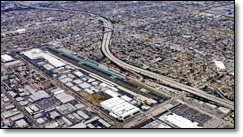
FAA rule hurts Hawthorne airport’s business – Aircraft traffic at Hawthorne Municipal Airport has dropped off this year, but not because of the poor economy or lack of interest from pilots.
Business at the airport was growing steadily after years of severe recession-related setbacks – until last fall, when Federal Aviation Administration officials changed safety standards.
The change made it difficult for planes to fly into Hawthorne at the same time as flights are coming into neighboring Los Angeles International Airport.
Pilots trying to land at Hawthorne’s Jack Northrop Field since September have either been diverted to other nearby airports or told to fly in circles when air traffic at LAX is heavy.
As a result, Hawthorne airport businesses report that they are losing tens of thousands of dollars a month in fuel revenue, hangar rentals and other service fees. Further, some local aviation experts believe the FAA has created a more dangerous situation.
“People are flying from across the country, and they are getting a few miles away when they are told: `You can’t get in,’ and they aren’t given a reason,” said Levi Stockton, owner of Advanced Air charter service at the airport. “It’s created a very dangerous situation.”
Though planes have safely flown into LAX and Hawthorne airport simultaneously for about 30 years, the FAA decided in September that their proximity could be a problem. That decision was largely because of new agency safety regulations.
The agency revoked Hawthorne’s waiver that allowed planes to come closer to each other than normally allowed as they approach the two airports. Without a waiver, planes have to maintain 3 miles of lateral separation and 1,000 feet of vertical separation in order to use their aircraft instruments to land.
The new FAA safety standards have generated a bevy of questions inside the organization about how much airplane separation is necessary in this situation, officials said.
“We determined that a more detailed safety assessment was warranted due to a change in FAA safety criteria,” agency spokesman Ian Gregor said. “Before issuing a new waiver, we need to do an exhaustive review to ensure that we would be able to maintain the highest levels of safety.”
Gregor said he is optimistic that the full waiver will be granted to Hawthorne airport sometime this summer.
Without the waiver, pilots flying into Hawthorne cannot use their instruments to guide them during peak traffic hours at LAX.
However, they still can fly into the airport if conditions are clear enough to allow landing visually without the help of air traffic controllers.
Local aviation expert Pat Carey believes the FAA has created a dangerous situation in the crowded Los Angeles airspace. He is co-chair of the Southern California Airspace Users Working Group, which examined safety concerns related to the proximity of planes during simultaneous approaches at LAX and Hawthorne and found it to be safe.
Carey said that the FAA’s waiver denial encourages pilots to make risky decisions to avoid having to land at an unfamiliar airport.
Pilots may disconnect from air traffic controllers and use visual approaches at times when it would be safer for them to use their instruments and communicate with air towers, he said.
“When you have airplanes out there that are not talking to the controllers, you’re going to have an accident,” Carey said. “There has been a huge effort for the last 10 years to get general aviation pilots comfortable talking to controllers.”
Carey said the 1986 midair plane crash over Cerritos should be used as a warning in this situation. Then, a light plane that was not using instruments or talking to controllers rammed into a DC-9 jetliner headed for LAX. Eighty-two people were killed.
Since then, aviation experts have made it a priority to encourage all aircraft pilots to communicate with controllers on the ground to try to avert such disasters, Carey said.
“When they’re not allowed to use instrument approach they have to revert to trying to stay visual when the weather is marginal,” Carey said. “When they do that in the confines of Los Angeles airspace, they run the risk of flying into the wrong airport or having an accident.”
If pilots are turned away from Hawthorne, air traffic controllers will either direct them to stay in the air until traffic eases, or divert them to an airport in Torrance, Long Beach, Santa Monica or LAX.
Ralph Mailloux, a plane owner who has flown in and out of Hawthorne’s airport for the past five years, said the FAA has made the airspace less safe by denying this waiver.
“More dangerous than anything is making circles in congested air space, and having planes just hovering in a holding pattern,” said Mailloux, executive director of the South Bay Regional Public Communications Authority in Hawthorne. “The key is, it’s not a normal route for us.”
Gregor said he does not believe the waiver cancellation has created a dangerous situation. Pilots are ultimately responsible for making safe flying decisions, he said.
“Everything we do is a standard, very carefully choreographed procedure – regardless if it’s a go-around at LAX or if someone has to go in a holding pattern,” Gregor said. “The pilot in command is always responsible for the safe operation of his or her aircraft.”
